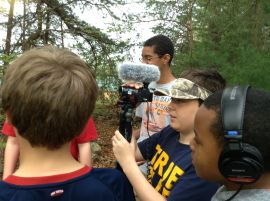 I remember the exact moment when it occurred to me that moving pictures could tell stories with such power and precision that words weren’t always necessary. I have to credit late director Cameron Crowe for putting that boom box in Loyd Dobbler’s hands as he stood below his true love’s window in that iconic scene from the 1980s. I remember thinking how nothing that character could have said would have better expressed what we the audience knew was in his wounded heart. It would be decades later before I would pick up a camera myself and attempt to tell a story, but the impression was deep and lasting.
I remember the exact moment when it occurred to me that moving pictures could tell stories with such power and precision that words weren’t always necessary. I have to credit late director Cameron Crowe for putting that boom box in Loyd Dobbler’s hands as he stood below his true love’s window in that iconic scene from the 1980s. I remember thinking how nothing that character could have said would have better expressed what we the audience knew was in his wounded heart. It would be decades later before I would pick up a camera myself and attempt to tell a story, but the impression was deep and lasting.
Today’s adoloscents came out of the womb watching Youtube videos, playing with interactive video games, and using complex programs to create animation, alter photographs and record hip-hop beats. But to throw the blanket term of “visual learner” upon them is to assume too much about how much they’re actually learning and what the visual component has to do with it. What I value most about teaching kids how to make movies or record music is the thought process that happens before any of them ever touch a camera or plug in a microphone. This process has nothing to do with technology and everything to do with leading them to discovering the story they want to tell, the idea they want to convey, and the experience of living that they wish to share.
What video and audio technology offers us is a way to engage our students in the less flashy “thinking part” of creation by dangling the alluring product before them. Kids know a good movie or a tight hook when they see or hear one. What they’re less sure of is how that movie got so good or why that lyric is so effective. By guiding them step by step through a process of conceptualization, visualization, graphic organization, planning and execution, they come to an understanding of how quality “happens.” The best part is that this understanding transfers to essay writing, algebric processes, chemistry experiments, and the analysis of political policy.
Perhaps more importantly, video and music production allow for the transfer from exterally perceived reality to internalized understanding and back to an external expression more fluidly and more concretely than almost any other medium. To “see the movie in your head,” as I suggest to students, and then make real what you see, is the most fundamental process of learning and doing. Along the way, kids encounter every conceivable obstacle in finding the right answer, but I have yet to see a student from any demographic throw up their hands and quit because it’s too hard. They nearly always dig deep into their own natural resources and find a workable solution that often surprises even me. And the reason for this is that they want to produce quality work and they have a million models of what that work should look or sound like.
 Not every kid I teach is going to being a future filmmaker or record producer. Some will likely never make another movie or write another song again. But I’m fairly certain that the experience of “making” and the pleasure of “creating” will follow them out of my class and into the next one they enter. And all of the core skills – writing, reading for comprehension, drawing, measuring, calculating, budgeting, collaborating, trying, failing, and trying again – have been used for all the most authentic purposes imaginable. And while there may be no State Standards test for creativty (yet), I like to imagine that these kids would ace it every single time.
Not every kid I teach is going to being a future filmmaker or record producer. Some will likely never make another movie or write another song again. But I’m fairly certain that the experience of “making” and the pleasure of “creating” will follow them out of my class and into the next one they enter. And all of the core skills – writing, reading for comprehension, drawing, measuring, calculating, budgeting, collaborating, trying, failing, and trying again – have been used for all the most authentic purposes imaginable. And while there may be no State Standards test for creativty (yet), I like to imagine that these kids would ace it every single time.